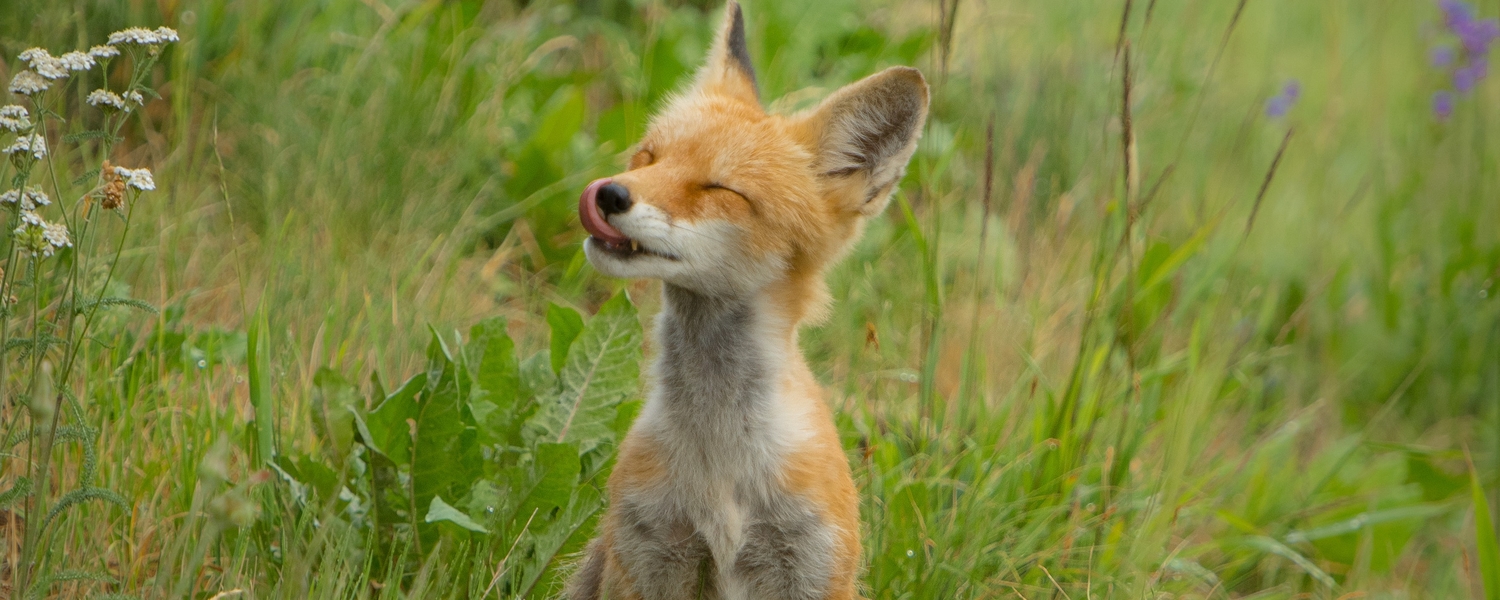
Wildlife Interactions
Wildlife Rehabilitation

Wildlife Rehabilitation
Wildlife rehabilitation is an emerging profession that blends veterinary medicine, natural history, animal behaviour, and environmental and animal ethics with public service and education. Wildlife rehabilitators offer first aid, supportive care, exercise and re-training to injured, sick, orphaned, and distressed wildlife, with the goal of releasing them back into their natural habitat. Certified Wildlife Rehabilitators are trained professionals that have obtained provincial and federal government permits to capture and care for wild animals when they become sick or injured for the purposes of returning these animals back to the wild.

The Alberta Institute for Wildlife Conservation (AIWC)
The Alberta Institute for Wildlife Conservation (AIWC) was created in 1993. AIWC IS dedicated to rescue, rehabilitation, and release. They have helped over 320,000 injured and orphaned wildlife. In 2021 alone, AIWC has admitted 948 patients, released 221 animals, and answered 3421 hotline calls. Wildlife rehabilitation can be important for maintaining our ecosystems and the animals that live within them. Wildlife rehab can also be vital in identifying zoonotic or other influential diseases in our surrounding areas. By identifying disease patterns in wildlife, we can have a huge impact in public health as well. It is a non-profit charity and an accredited veterinary clinic. They are located north west, just outside of the city of Calgary.
Why Rehabilitation?
Hover over the pictures below to learn more!
Wildlife Rehabilitation Centres In and Around Calgary
"See a Hare, Leave it There"
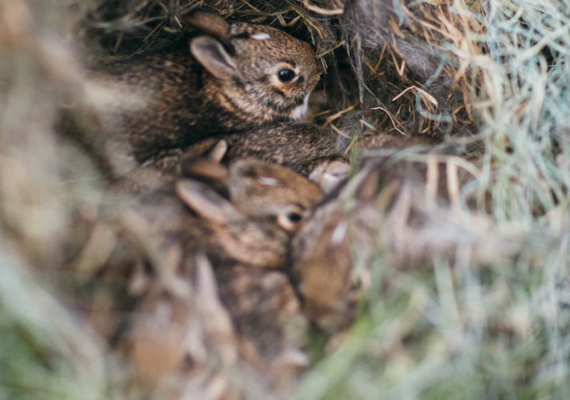
Keep Wildlife Wild
Have you or your friends/family ever seen a baby animal, like baby hares, squirrels, or birds, by themselves outside? What did you do? The best thing you can do when you see a baby animal by themselves outside is LEAVE THEM ALONE! It may be hard, but unfortunately trying to provide help to these animals causes much more harm than good. It often removes them from their parents and makes it unlikely that they will survive.
So, next time you or your friends or family see a baby animal alone outside, leave it there, unless it is obviously injured or in a dangerous environment! If you are ever unsure of what to do: call the AIWC hotline 403-946-2361 to consult them for advice!

Orphaned Wildlife
Each spring, wildlife rehabilitation facilities are filled with tiny orphaned baby mammals like squirrels and hares. It is normal for baby hares to be found alone. It is important not to kidnap them, they are not orphaned.
Hares are born fully furred with their eyes open able to hop around. This enables the mother hare to leave their young for long periods of time under bushes or grass to protect them from predators, while scavenging for food. It is normal for baby hares to be found alone.
If the hare is not obviously injured or in a dangerous place, leave it there! Hares do not survive well in captivity and often die due to stress during handling.
Another Reason to Not Touch Wildlife

Rabies is a preventable viral disease that is most often transmitted through animal bites and scratches
The rabies virus moves through the body to the brain, ending in death. The best way to prevent getting rabies is to stay away from wildlife!
The most common wild animals to have rabies are raccoons, skunks, bats, and foxes, although any mammal could have rabies. Cats, dogs, and cattle can also get rabies. Veterinarians often vaccinate cats, dogs and veterinary staff for rabies to decrease the risk of getting this disease.
There are also many other bad diseases and parasites that you can get from touching and interacting with wildlife! So if you see wildlife, leave it alone and do NOT touch it!
Wildlife Handling & Interactions

Handling Wildlife
The only time that people should be handling wildlife is when wildlife are distressed and injured and need help from trained professionals, such as staff at a wildlife rehabilitation facility.
When people are handling wildlife it is VERY important to do it as calmly as possible to create the least stress as possible. Because wildlife live and belong outside, human intervention/handling is extremely stressful for these animals, to the point that it can kill them, so it is very important to treat wildlife with respect.

Animal Rescue
There are a variety of techniques that we can use to reduce stress for the animal and ensure that the handling is safe for both the animal and people. Please leave this to the professionals and DO NOT EVER try these at home! Some examples of these techniques include:
1. Eye Covering - Covering the animal's eyes so they cannot see what's happening to reduce their stress and make it more challenging to intentionally hurt people.
2. Safety Goggles - Birds like loons with longs beaks are likely to try and poke peoples eyes when handling so its best to wear goggles to prevent this.
3. Towels - Towels are a great tool to help restrain animals and act as a barrier to reduce scratching or biting.
4. Leather gloves - Birds of prey have long sharp talons that can cause serious injuries, so we wear thick leather gloves to reduce injuries.
Wildlife Parasites

Parasitism in Wildlife
Parasites are living organisms that live on or in another living organism, called a host, for resources like food and shelter. While obtaining these resources, parasites often harm their host.
Wildlife are prone to acquiring lots of different types of parasites. The types of parasites they can acquire depends on their lifestyle and where they live.
For example, tapeworms, a parasitic worm that lives in the digestive system of its host, are common to wild rabbits in Alberta.

Ticks
Ticks are ectoparasites that bite and feed on the blood of mammals. The most common species of tick in Alberta is the black legged tick. Ticks carry many diseases that can spread to animals through the tick's saliva when they bite/feed. Ticks spread diseases like lyme disease, babesiosis, anaplasmosis and many more that pose a huge problem for wildlife, our pets, livestock, and ourselves. Ticks are now migrating more north due to climate change, which increases the spread of diseases.
If you find a tick on yourself or your pets after an outdoor adventure, carefully remove the tick with tweezers, grabbing as close as possible to the skins surface, and pulling upward with steady and even pressure. Dispose of the tick in a plastic bag or down the toilet. Wash the area with soap and water. If you remove a tick from your pet, save the tick in a plastic bag or container for your veterinarian to submit the tick to be tested for different diseases.
Cytology Activity
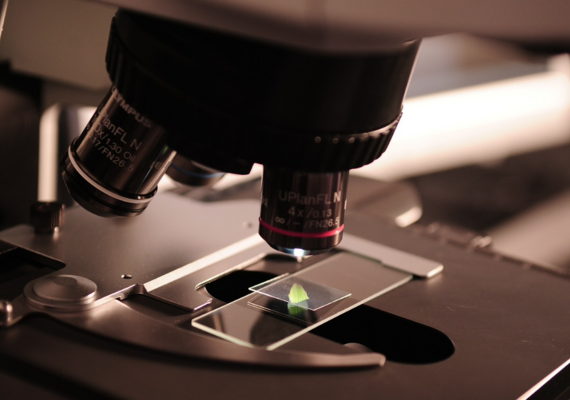
Cytology is the microscopic examination of cells that have been collected from the body
Cytology is an important diagnostic used to look at lumps, organs, body fluids, and surfaces of the body. There are several different methods to collect cells from tissues depending on where and what type of tissue we want to collect. Cytology is a simple and non-invasive method of gathering information about the body, however it can only tell part of the story.
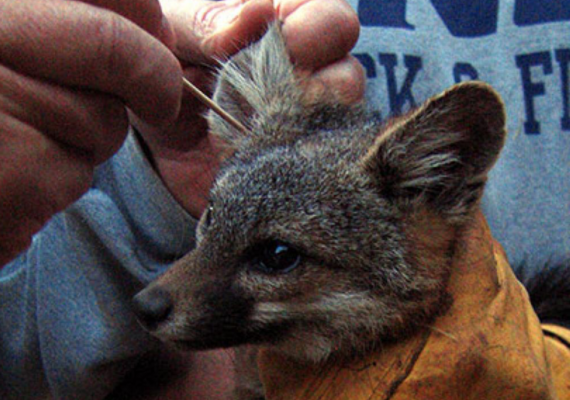
SCENARIO
A fox presents to the rehabilitation facility where you are working. The foxes ears are red, swollen, crusty, and appear itchy. The fox does not like when you touch its ears. You are smart, and take a cotton swab and gather some of the debris from inside the fox's ear. You slather the debris on a microscope slide to take a closer look.

Ear Mites
What you see through your microscope confirms your suspicions. This fox has ear mites! Ear mites are surface parasites that live in the ear canal and eat ear wax and other ear secretions. Ear mites can infect rabbits, cats, dogs, ferrets, foxes and many more animals.
Ear mites are almost invisible to the naked eye! This is why we need to confirm our suspicions, and ensure that there is not something else going on, by looking at the ear debris under the microscope.
In order to make our fox friend feel better, we can put ear medications inside its ears to kill the ear mites and their eggs. Doing so will make the fox's ears less itchy and irritated!

Window collisions
Did you know that 16-42 million birds per year in Canada are killed by colliding with windows? Window collisions are a significant threat to birds. It is one of the greatest sources of human caused death of birds. Most birds die on impact, however those that survive are left with life threatening injuries such as concussions, shock, internal bleeding, brain damage, and broken bones.
Birds are very important for our ecosystem as they play roles in pest control and seed dispersal. We must do what we can to prevent these human caused injuries and deaths to birds. One of the ways we can do this is by creating decals for our windows to make the windows more visible to birds and decrease their risk of colliding with them.
Proper Waste Disposal

Did you know that 1,000,000 animals die each year because of littering?
Litter is everywhere, and not only is it bad for the environment but it is also hazardous to wildlife. When animals are searching for food, animals are drawn in by the smell of litter, but are not aware of how dangerous it can be. Animals can get their heads stuck in jars, cut themselves on glass, eat toxic or household waste, eat plastic, and get tangled in ropes and fishing equipment. In Alberta, the two most common wildlife injuries related to litter are vehicle collisions and fishing line entanglement or ingestion. Thus, it is very important to dispose of waste properly in order to prevent animal injury, death, and help keep the wild, wild.

How you can keep wildlife safe from litter
1. Never litter!
2. Make sure your garbage and recycling bins have secure and proper fitting lids
3. Crush pop cans before recycling them
4. Put lids back on containers, once rinsed and ready to recycle
5. Cut plastic 6 pack rings
6. Tie a knot in the middle plastic bags
7. Properly dispose of household and toxic chemicals
8. Never do a balloon releasing event
9. Educate others
Humane Wildlife Trapping
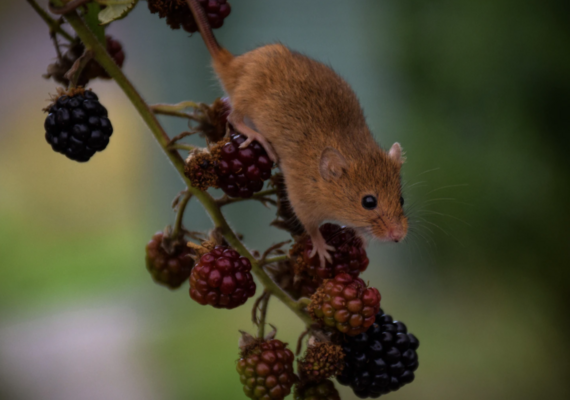
Humane Mouse Traps
Have you or a friend ever had an unwanted mouse friend in their house, shed, or other property before? What did you do about it?
Opportunistic mice take advantage of our warm and resourceful homes and can cause problems and become huge nuisances. They can eat your food, leave mouse droppings everywhere, destroy furniture, contaminate your home and spread diseases. For these reasons and many others we need to remove unwanted mice friends from our properties.
There are many ways that we can try and remove these mice from our homes. You have likely heard of mouse traps before, but did you know that some mouse traps are extremely inhumane, and that there are many options that can remove these unwanted friends from your properties without causing them distress or pain?

* WARNING sensitive material ahead. Please proceed with caution *
Not only are some mouse traps very inhumane and cause pain and distress to mice, but other animals like wildlife and even our own pets can become injured by these traps.
One of these traps include sticky or glue traps. These are traps that are boards or sheets that are covered in extremely sticky adhesive or glue so that anything that touches it becomes stuck and unable to escape. These traps do not immediately kill animals, nor do they allow them to be easily released, but rather unintentionally injure the animal when they are struggling to become free or starve them. Often these traps also unintentionally trap and harm wildlife and our pets. Wildlife or pets that become stuck to glue traps often become severely injured and in extreme cases must be humanely euthanized.
Additionally, any traps that drown their victims are also extremely inhumane.

*WARNING sensitive material ahead. Please proceed with caution*
When rodents become pests, another way people tend to manage their populations is through poisoning them with rodent poison otherwise known as rodenticides. Rodenticides come in many forms, however most of them disguise themselves as appetizing food for rodents to entice the rodents to eat them. Most rodenticides act as anticoagulants, meaning that they interfere with normal blood clotting, causing bleeding, and often ending in death. However, rodenticides typically only kill about half of the targeted rodent population. Additionally, rodenticides are often consumed by unintended animals, like wildlife, our own pets, and even children and can cause devastating health consequences and death. Predators can also consume the carcasses of rodents or other animals killed by rodenticides, and the rodenticides in the carcass can cause the same effects in the predators, which can result in health consequences and even death.
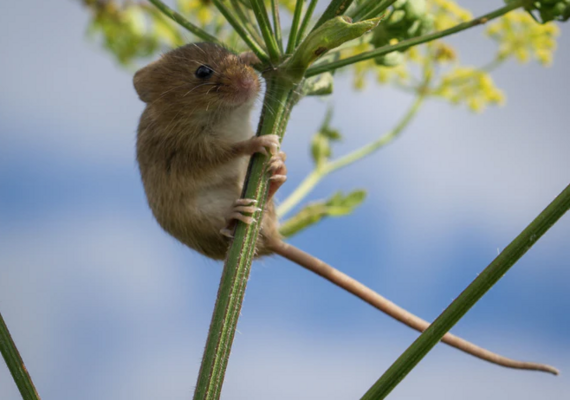
Use Humane Options Properly
There are humane options that allow us to remove unwanted rodent friends from our properties, without harming them or causing them distress, or unintentionally causing harm to other animals. There are many humane rodent traps that offer the option of relocation. Live capture traps, use bait to entice rodents to enter them, then quickly close the entrance so the rodent cannot escape. These traps can be later opened to allow the mouse to escape in a more appropriate and more wild area where they belong. However, these traps need to be regularly monitored in order to ensure the health and wellness of the rodent. You can easily buy these traps from hardware stores, online, and even easily make your own, making them a great option for humans and our rodent friends.
Protect the Pollinators
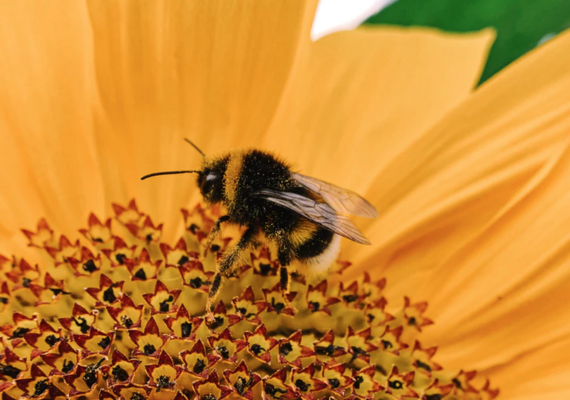
Pollinators are Important
Did you know that insects play a crucial role in our environment as pollinators for our plants and crops? 90% of all flowering plants cannot reproduce without the help of pollinators. Insects are very important and their livelihood not only affects the health of our environment but also our agriculture and economy.
Bees, butterflies, beetles, flies, and many other insects act as very important pollinators. Plants produce pollen, particles necessary for their reproduction, that are transferred to other plants/flowers by insects to help aid in their reproduction. When insects feed on the sugary nectar of plants, the pollen sticks to their body, and when they go to look for food at a different plant, this pollen is transferred. This process is vital to plant reproduction as this is often the only way that most plants can share their pollen.

Pollinators at Risk
Several pollinators in Canada have been categorized as at risk of extinction. But there's hope, we can do our part to save the pollinators! We can...
1. Plant a pollinator-friendly garden with native plants like milkweed, goldenrod, phlox, Queen Anne's lace, common thistle, black-eyed Susan, and asters
2. Build a bee nest out of a milk carton or wooden box
3. Encourage your family and others to refrain from removing colonies of native bees from their property
4. Educate your family and others to choose alternatives to pesticides and reduce the amount of chemicals they use

Pollinators give us Honey
Not only are bees vital pollinators, but they also produce food... HONEY! In 2015, Canada had a total of 720,000 colonies of bees which produced 95 million pounds of honey, bringing in major income to Canada.
Bee Keepers keep bees in apiaries. Apiaries are a series of colonies or hives in boxes containing frames in which the bees live, reproduce, and produce honey!

Did you know that veterinarians also treat honey bees?
Sometimes hives can become sick and need treatment with antibiotics that must be prescribed by veterinarians! In 2018, a new bylaw was passed requiring certain antibiotics to be prescribed by a veterinarian or doctor, which subsequently resulted in veterinarians being required to become more involved with the management of honey bee colonies!
Because of the growing role of veterinarians in the health of honey bees, our veterinary school has set up its own apiary to help us learn more about bees, their care, and their vital role in our environment! We also have a student run bee club where we can learn more about honey bees and connect with other bee lovers! Some of our students even have their own hives!
Teaching Apiary
Watch this video to see our UCVM teaching apiary and some of our student caring for our fabulous teaching bees!
